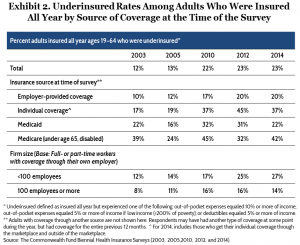Commonwealth Fund: “Underinsurance” Unchanged Under Obamacare
Yet another pro-Obamacare organization has had to publish a study indicating that Obamacare is failing to achieve its objectives. I recently discussed Families USA’s report that one third of low income families cannot afford care under Obamacare.
This time it is the Commonwealth Fund, inventor of the notion of “underinsurance,” which is defined as out-of-pocket health costs (excluding premiums) comprising at least 10 percent of household income, or five percent if household income is less than 200 percent of the Federal Poverty Level.
In 2014, the proportion of so-called “underinsured”, aged 18-64, was 23 percent – exactly the same as in 2012 and just one percentage point more than in 2010.
I am not going to spend too much time on the numbers, because I find the whole concept of “underinsurance” arbitrary and misleading. As Greg Scandlen pointed out, the average Medicare beneficiary is well on the wrong side of the line, according to this measurement.
Further, it is wrong to compare the current year’s income to current year’s health spending. The whole point of benefits like Health Savings Accounts is to allow a person whose health spending is a trivial share of income in most years to save money so that he has a significant balance to spend when he falls sick. This minimizes the friction and bureaucracy of health insurance.
Nevertheless, it is interesting to note the composition of the so-called “uniderinsured.” Exhibit 2 shows that those with employer-based coverage, the individually insured (which now includes those insured via Obamacare exchanges), and those under 65 on Medicare, have about the same proportion of “underinsured” people as in 2010. The Medicaid population has significantly fewer. I’d bet that this is because Obamacare’s sales and marketing efforts have recruited more healthy people into Medicaid.
But the real zinger is 2003: Employer-insured and individually insured populations had significantly fewer “underinsured” than in 2010 or 2014, while Medicaid and Medicare had effectively the same proportion of “underinsured.”
So, wouldn’t it make more sense for the Commonwealth Fund to advocate that health policy return to where it was in 2003, rather than continue down the path of Obamacare?



The concept of underinsured focuses on the negative – the percentage of out of pocket costs in relation to incomepretty
Why not focus or at least
acknowledge the percentage of income paid by insurance which could be over 100 percent
Don Levit
I think that’s what we at NCPA have called the over insured.
John:
You have got to be kidding.
If not, when is one “properly” insured?
Don Levit
It depends on the diagnosis, I would say.
The NY Times had the column by Krugman in which he stated that 47% of Americans would have trouble coming up with $400 for an unexpected expense.
On that basis, any insurance policy with a deductible over $250 would leave some people underinsured.
For all its vices, I think that is why Medicaid is so popular. Lousy care is less important than low deductibles to many persons.
That is surely true. However, many people would not need insurance except at a very high attachment point. Let’s start at the top: Does Bill Gates need health insurance? Of course not. Do taxpayers need Bill Gates to have health insurance? Of course not. (He is not going to be admitted to the Emergency Department and not pay his bill.)
One reason for HSAs and the like is to move towards equal tax treatment of direct health spending and that mediated by an insurer. We still need a drastic reduction in the proportion of health spending mediated by insurers so that prices can be formed efficiently (in the economic sense).